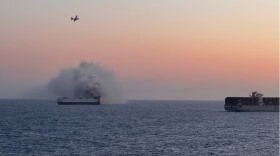The Aleut Corp., Adak’s regional Native corporation, signed an agreement in May to lease 3,500 acres to Pacific H2, an Oregon-based energy company. The 90-year lease allows Pacific H2 to build wind turbines that would power a permanently docked green ammonia plant in Adak’s harbor. The facility would be Alaska’s first green ammonia plant.
“This is a transformational opportunity for Aleut and for Adak,” said Skoey Vergen, CEO of the Aleut Corp. “It isn't just a clean energy project, it's an economic engine for Adak and the entire Aleut region.”
Vergen described the green ammonia facility as a potential “anchor point” for revitalizing Adak, an island that formerly housed a large military base.
The project would be Pacific H2’s first facility and could cost nearly $2 billion to complete. The company plans to start a yearlong wind study this summer for the 70 wind turbines proposed for the project.
Pacific H2 said the green ammonia facility could bring 150 jobs to Adak, where about 50 people live today. The island has a lot of abandoned infrastructure from a naval air station that closed in 1997, and residents have been looking into ways to revitalize their community.
Adak City Manager Breck Craig said the community is mostly excited about the facility’s potential benefits, like high-paying jobs and access to renewable energy.
“It's a real game changer, as long as they can address the environmental concerns around ammonia,” Craig said.
So what exactly is green ammonia? It’s not the color that makes it “green” – it’s how the ammonia is produced. While conventional ammonia production relies heavily on fossil fuels, green ammonia is produced entirely using renewable energy sources.
Pacific H2 would use Adak’s wind and water to power and produce the facility. The company expects the plant will make more than 2,000 tons of ammonia annually.

Ammonia can be toxic in high concentrations, a particular concern given that part of Adak lies within the federally protected Alaska Maritime National Wildlife Refuge.
Pacific H2’s CEO Charles Deister said the facility would follow established safety protocols used in industrial ammonia plants for decades, including double-walled pipes and multiple containment systems.
“We’ll have gas detection systems, emergency ventilation systems, there'll be various alarms, automatic shutdown valves,” Deister said in a community presentation in June.
The company also plans to establish a “buffer zone” prohibiting vessel traffic around the facility.
So why invest in green ammonia? According to Deister, green ammonia is in high demand in Asia, making Adak’s location ideal for shipping.
“Adak is as far west as we can get. It reduces the shipping time to the lowest possible,” he said. “For example, Adak to Tokyo is a seven-day shipping time at 14 knots.”
The project still needs permits and environmental reviews, which could take several years. After those approvals, Pacific H2 would need to secure the $1.7 to $2.5 billion in funding. If all goes according to plan, the facility could begin producing green ammonia by 2032.







